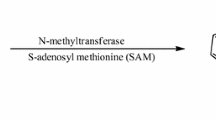Summary
Oxitropium bromide (OXBR) is a new anticholinergic drug, which is expected to be useful in the treatment of nocturnal asthma. The only pharmacokinetic data were obtained with the14C-labelled compound. A sensitive radioreceptor assay for the determination of unlabelled OXBR in plasma was developed, based on competition between OXBR and3H-N-methylscopolamine for binding to muscarinic receptors. OXBR was isolated from plasma by ion-pair extraction and re-extraction. Active metabolites present in significant amounts might interfere in the assay, but this was not the case for OXBR metabolites. Detection limits were 300 pg·ml−1 and 3 ng·ml−1 for plasma and urine, respectively. For the latter no extraction step was required. The single dose pharmacokinetics of OXBR was studied following inhalation (3 mg), oral (2 mg) and i.v. (1 mg) administration to 12 men, following an open, cross-over design.
After i.v. administration the kinetic parameters were: Vc 38.4 l; t1/2α 5.3 min; t1/2β 142 min; AUC 8.9 h·ng·ml−1; renal excretion 50.2%, k10 3.5 l·h−1 and total clearance 1874 ml/min. The apparent bioavailabilities were 0.48% and 12.4% by the oral and inhalation routes, respectively, based on the cumulative renal excretion. There were moderate adverse reactions due to the anticholinergic properties of the drug.
Similar content being viewed by others
References
Banholzer R, Pook K-H (1985) Synthese von anticholinerg wirksamen N-Alkylnorscopolaminen und deren Quartärsalzen unter besonderer Berücksichtigung des Bronchospasmolytikums (−)-N-Ethylnorscopolamin-methobromid (Ba 253 BR). Arzneimittelforsch/Drug Res 35: 217–228
Bauer R (1985) Zur Pharmakologie des Bronchospasmolytikums Oxitropiumbromid. Arzneimittelforsch/Drug Res 35: 435–440
Beumer HM, Grieben Chr, Schuijt C, Siebelink J (1981) Oxitropium bromide in bronchial asthma: Comparison of metered dose inhaler and powder inhalation of the anticholinergic bronchodilator oxitropium bromide in protection against acetylcholine and histamine provocation. J Clin Pharmacol Ther Toxicol 19: 168–170
Frith PA, Atkinson JA (1987) Airway anticholinergic effects of oxitropium. Postgraduate Med J 63 [Suppl 1]: 5a
Lal S, Mitra SK, Eyre-Brook A, Gribben D (1987) Oxitropium bromide in chronic bronchitis. Postgraduate Med J 63 [Suppl 1]: 23a
Pavia D, Lopez-Vidriero MT, Agnew JE, Taylor RG, Eyre-Brook A, Lawton WA, Pellow PGD, Clarke SW (1987) Effect of four weeks' oxitropium bromide treatment of lung mucociliary clearance in patients with chronic bronchitis or asthma. Postgrad Med J 63 [Suppl 1]: 15a
Frith PA, Jenner B, Dangerfield R, Atkinson J, Drennan C (1986) Oxitropium bromide. Dose-response and time-response study of a new anticholinergic bronchodilator drug. Chest 89: 249–253
Bellia V, Cibella F, Insalaco G, Mirto M, Peralta G, Visconti A, Schiassi M (1987) Comparison of the effectiveness of oxitropium bromide and of a slow-release theophylline in the prevention of ‘morning dip’ in asthmatics (preliminary results). Postgrad Med J 63 [Suppl 1]: 9a
Ensing K, Kluivingh F, Gerding TK, De Zeeuw RA (1984) Development of a sensitive radioreceptor assay for oxyphenonium in plasma and urine. J Pharm Pharmacol 36: 235–239
Ensing K, Pol M, De Zeeuw RA (1988) Radioreceptor assays of ipratropium bromide in plasma and urine. J Pharm Biomed Anal 6: 433–439
Ensing K, In 't Hout WG, Halma P, Klinkers HMJ, Ensing GJ, De Zeeuw RA (1988) Development and application of a radioreceptor assay for scopolamine. Arzneimittelforsch/Drug Res 38: 106–111
Ensing K, De Zeeuw RA, Hörnchen U, Schüttler J, Stoeckel H (1987) Determination of atropine in plasma by a direct radioreceptor assay. Pharm Weekbl [Sci] 9: 321–323
Ensing K, In 't Hout WG, De Zeeuw RA (1987) Lyophilised receptor preparation for a radioreceptor assay for anticholinergics. Anal Letters 20: 489–502
Ensing K, De Zeeuw RA (1984) Pre-incubation and low temperatures in quantitative radioreceptor assays. Anal Letters 17: 1647–1658
Wahl D, Förster H-J, Pook K-H, Richter I (1985) Biochemische Untersuchungen mit Oxitropiumbromid. 1. Pharmakokinetik und Metabolismus in Ratte und Hund. Arzneimittelforsch/Drug Res 35: 255–265
Wahl D, Van Wayjen RGA, Van den Ende AA (1985) Biochemische Untersuchungen mit Oxitropiumbromid. 2. Pharmakokinetik und Metabolismus in Menschen. Arzneimittelforsch/Drug Res 35: 266–276
Ensing K, De Zeeuw RA, Nossent GD, Koëter GH, Cornelissen PJG (1989) Pharmacokinetics of ipratropium bromide after single dose inhalation and oral and intravenous administration. Eur J Clin Pharmacol 36: 189–194
Soeterboek AM (1979) Pharmacological characteristics of some anticholinergic drugs in man. Ph.D. Thesis. Faculty of Mathematics and Natural Sciences, Groningen, The Netherlands
Munson PJ, Rodbard D (1980) Ligand: A versatile computerized approach for characterization of ligand-binding systems. Anal Biochem 107: 220–239
Author information
Authors and Affiliations
Rights and permissions
About this article
Cite this article
Ensing, K., de Zeeuw, R.A., in't Hout, W.G. et al. Application of a radioreceptor assay in a pharmacokinetic study of oxitropium bromide in healthy volunteers after single i.v., oral and inhalation doses. Eur J Clin Pharmacol 37, 507–512 (1989). https://doi.org/10.1007/BF00558132
Received:
Accepted:
Issue Date:
DOI: https://doi.org/10.1007/BF00558132




